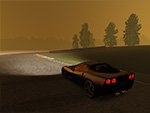
| Home | Out with Cg, in with GLSL. |

|
|
|
Introduction
GLSL has since long been a part of the OpenGL standard. Back when Racer started using GPU shaders, the language wasn't quite stable yet. But it has grown since then, and has some features that make it interesting now.
There are some drawbacks as well though.
Therefore, Racer has created its own shell around the thin layer of GLSL, to be more programmer-friendly.
Racer's GLSL implementation
Racer uses GLSL but has some additions and prerequisites:
out vec4 fragColor;
void main(void)
{
fragColor=vec4(1.0, 0.0, 0.0, 1.0);
}
Uniform block parameters
GLSL allows 'uniform blocks'. These are GPU-located buffers where a number of parameters are set. These parameters can be shared across all programs. For example, with Cg, Racer had to set the ModelViewProject matrix (MVP) for all shaders separately each frame. With GLSL, you can set one global block of parameters that apply to all GLSL programs, and be done with it.
Racer hardcodes a uniform block that is defined in data/renderer/common/globals.glsl. This is defined as:
layout(std140) uniform WorldGlobals
{
... (parameter definitions)
} globals;
This defines a structure that should not be modified by the user, as it is reflected in Racer itself (in C++). The name 'WorldGlobals' stems from 'World', which is the internal name for the scenegraph/rendering engine that Racer uses.
Parameters are then referenced using for example globals.modelViewProj. A number of parameters that are the same for each program is listed below:
| Name (globals.*) | Description |
| exposure | Exposure value, somewhere between 0 and 1 probably. (i.e. 'uniform float exposure'). |
Uniform names
GLSL uses 'uniform' variables to pass parameters that don't change per vertex, but at most only once per object/shader. In principle it would be possible to create a binding from a uniform name to a uniform's contextual meaning (like 'bind mvp ModelViewMatrix') but that means that you have to learn the binding meanings anyway. Racer is taking the way that the uniform names must be specific, so they can be found and set to their intended value.
These uniforms normally vary per material (Racer shader); a lot of parameters are in the 'globals' uniform block above. However, some parameters such as diffuse/ambient colors can differ per material, so are defined locally per GLSL program.
Here is a list of the currently defined uniform names. They must be used exactly for Racer to find them, and set them to the correct value.
| Name | Type | Description |
| diffuse | vec3 | RGB color defining the diffuse color of the material |
| fragColor | vec4 | The output color for a fragment shader. I.e. 'out vec4 fragColor'. |
| tex0 | vec2 | Texture in first texture unit (i.e. 'uniform sampler tex0') |
| tex1 | vec2 | Texture in 2nd texture unit |
| tex2 | vec2 | Texture in 3rd texture unit |
| tex3 | vec2 | Texture in 4th texture unit |
| tex4 | vec2 | Texture in 5th texture unit |
| tex5 | vec2 | Texture in 6th texture unit |
| tex6 | vec2 | Texture in 7th texture unit |
| tex7 | vec2 | Texture in 8th texture unit |
Attribute names
GLSL uses 'attribute' variables to pass per-vertex data. Similary to uniforms, these variables must be given explicit names to work ok. According to nVidia, a lot of these attribute indices are hardcoded, to be compatible with older software. For example, vertex data is attribute index 0, normals are attribute index 2 etc.
Here is a list of the currently defined attribute names. They must be used exactly for Racer to find them, and set them to the correct value. For example:
| Attribute name | Attribute index | Description |
| inVertex | 0 | in vec4 inVertex; incoming vertex position XYZ and W. |
| inNormal | 2 | in vec3 inNormal; incoming normals. |
| inColor | 3 | RGB |
| inSecondaryColor | 4 | RGB; probably unusable in Racer, since there's no way to set it for a shader. |
| inFogCoord | 5 | Unusable in Racer |
| inMultiTexCoord0 | 8 | First set of texture coordinates; the most used. |
| inMultiTexCoord1 | 9 | 2nd set of texture coordinates |
| inMultiTexCoord2 | 10 | 3rd set |
| inMultiTexCoord3 | 11 | 4th set |
| inMultiTexCoord4 | 12 | 5th set |
| inMultiTexCoord5 | 13 | 6th set |
| inMultiTexCoord6 | 14 | 7th set |
| inMultiTexCoord7 | 15 | 8th set |
Convert Cg into GLSL
Racer has used Cg for a long time, so you might be familiar with it. Here is a list of things you will encounter when transitioning from Cg to GLSL:
(last updated November 13, 2012 )